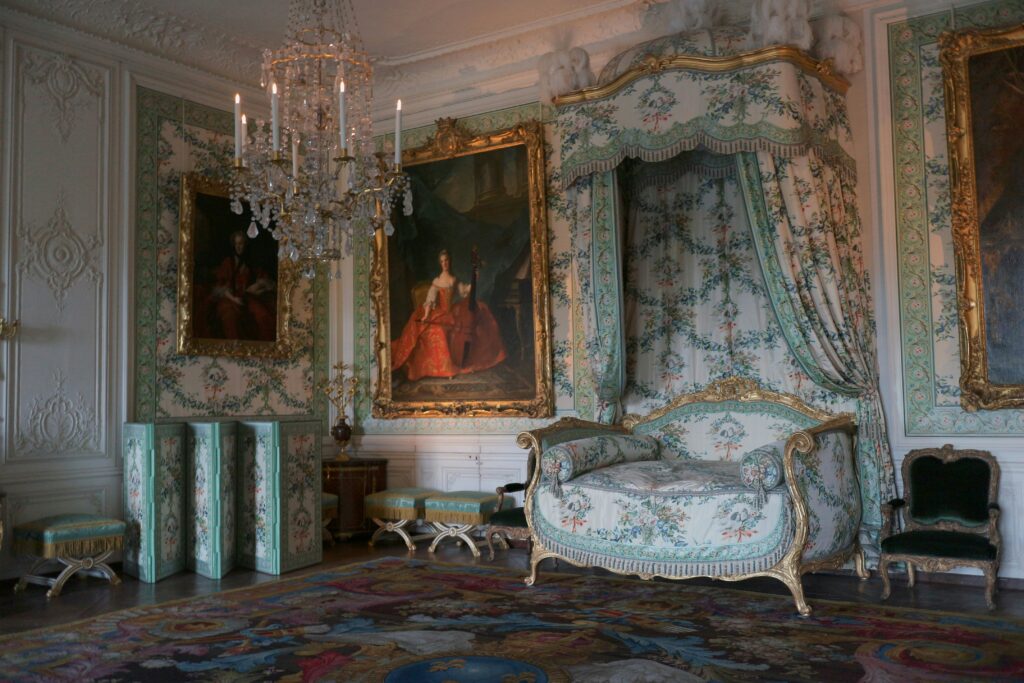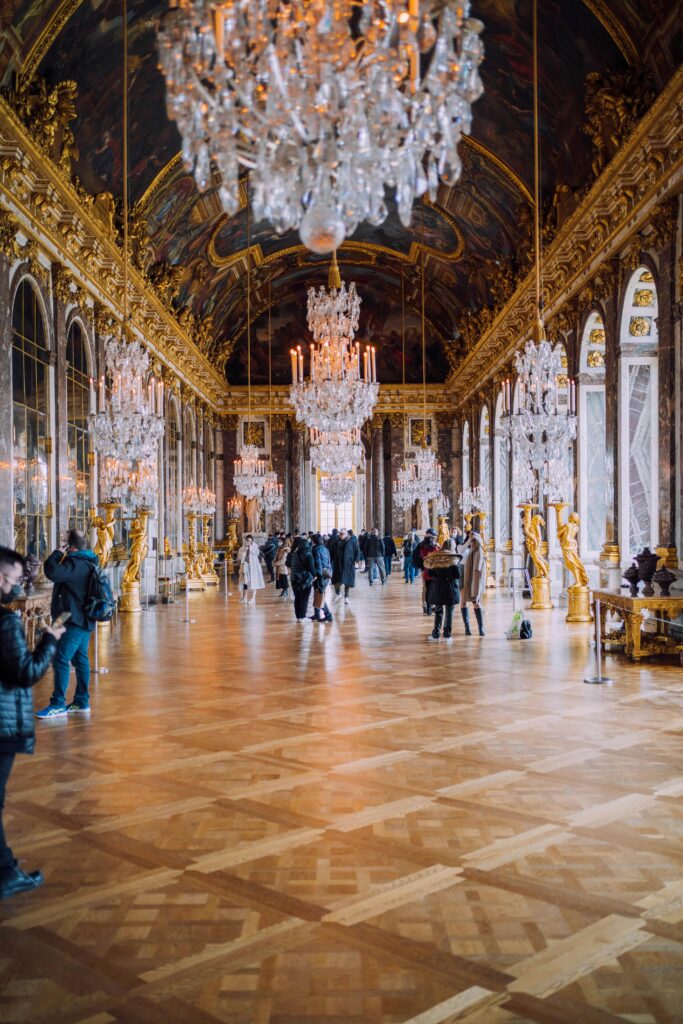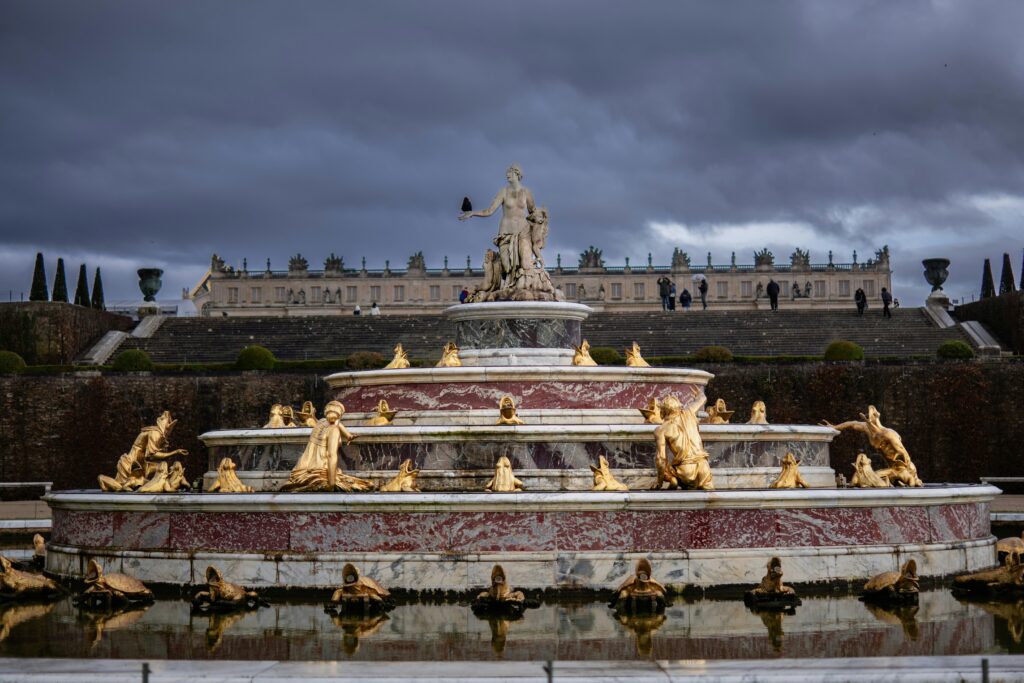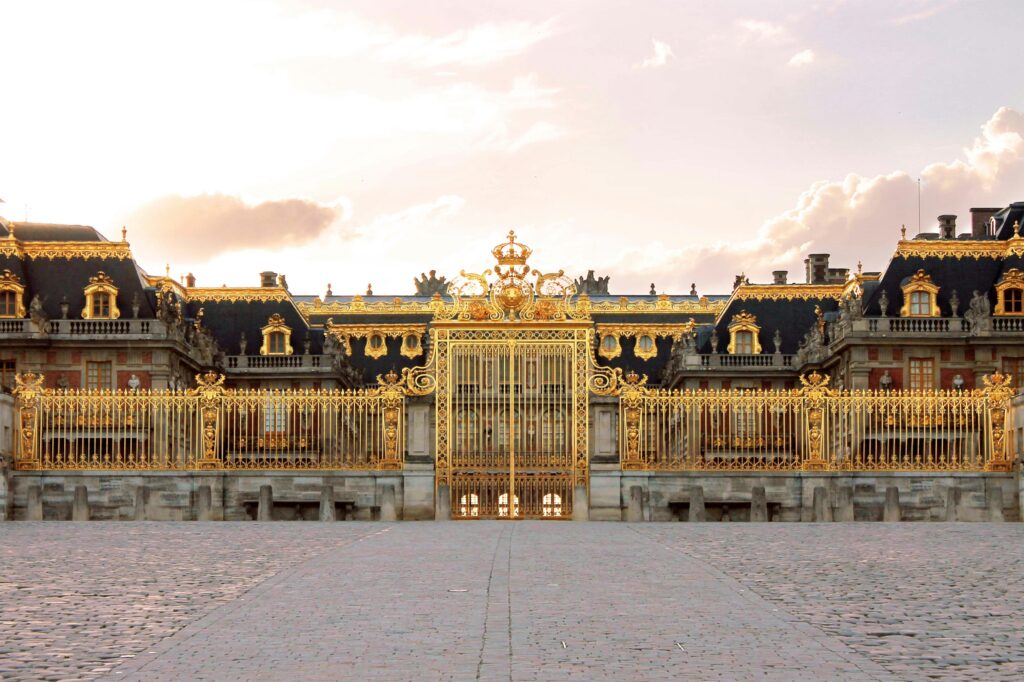What is in the Palace of Versailles?
Versailles Palace is a developed storehouse of history, culture, charm, and luxury. Do you know what is in the Palace of Versailles, who lived in the Palace of Versailles, & What is the Palace of Versailles is famous for? Let’s talk about this.
Entering this hall, you find yourself facing the corridor of mirrors, 357 multiplied by the sunlight reflected through 17 windows, reminding you of the power and the place of the reign of King Louis XIV. Some of the palace’s apartments, such as the King’s Grand Apartments, are decorated with paintings, gold leaf, and fancy furniture, with the rooms narrating some stories of the life of the royal court.

Besides the rich furniture of the rooms themselves, the grounds are gorgeous. These animated gardens were finished by André Le Nôtre and enhanced over 2,000 hectares of amazing fountains, statues, and a mesmerizing Orangerie. The gardens are lovely for a pleasant walk, and one can easily crave some of the grand scenic performances in this palace.
It also contains the former application of the Petit Trianon, now known as Queen’s Hamlet, which Marie Antoinette built to avoid the palace etiquette. This delightful part presents better the royals’ private side than the palace’s proper beauty.

My Opinion
It’s not only about watching an old castle; it’s about feeling the atmosphere of royal life in France, feeling oneself a guest of the Versailles Palace, seeing the magnificent work of masters and artists, and feeling the great size of the Palace.
Who lived in the Palace of Versailles?
Answer
The Palace of Versailles was home to French monarchs, especially Louis the Fourteenth, who continued on the hunting residence, transforming it into a royal chateau at the end of the seventeenth century.

Louis XV and Louis XVI, also residing in Versailles after Louis XIV. In addition to being the king’s residence, it also housed the nobles and ministers as well as the following, who aided the king in the running of the monarchy. Probably the most well-known citizen of Versailles was Queen Marie Antoinette, who was blamed for flirting and excesses that led the French royal family to the guillotine. France’s political workplace up to the French Revolution in 1789 was the Palace, which became the working and living place of a royal family until they left for Versailles from Paris.
What is the Palace of Versailles famous for?
Answer
Versailles Palace is generally known for its majesty and as a home to the royal residence and symbol of the absolute monarchism of Louis XIV. Famous for the hall of mirrors, this palace is one of the best examples of Louis XIV’s desire for the beauty of France.

Another feature of the palace is also wide, well-planned gardens that have also become a model for the European landscape gardens. Also, Versailles has always had an interesting history; during that time in France, it was the main place where intent was given for the French Revolution. Today, it belongs to the UNESCO list of cultural sites, and it is among the symbols of France.
SEE ALSO
- Cologne Cathedral Interior | Artworks & Facts | German’s Site
- Top 10 Things To Do In Hilo | Hawaii’s Big Island
What’s Inside the Palace of Versailles: Exploring Room by Room
The Palace of Versailles contains some of the most spectacular interior spaces ever created. Each room tells a story of power, artistry, and the evolution of French design. Here’s a detailed look at the palace’s most significant spaces:
The Hall of Mirrors (Galerie des Glaces)
The Hall of Mirrors represents the pinnacle of Versailles’ splendor and serves as its most iconic space. This 73-meter-long galley features:
- 17 large mirrors facing 17 arcaded windows, creating a play of light that was revolutionary for its time
- 30 painted compositions on the ceiling by Charles Le Brun, depicting the glorious achievements of Louis XIV’s first 20 years of reign
- Crystal chandeliers hanging from the vaulted ceiling, reflecting light throughout the space
- Marble walls and gilt bronze decorations exemplify French Baroque aesthetics
Historically significant as the site where the Treaty of Versailles was signed in 1919, ending World War I, the Hall of Mirrors served as the primary ceremonial gallery where the king would pass each day on his way from his apartments to the chapel.
The King’s State Apartments (Grands Appartements du Roi)
The King’s State Apartments consist of seven rooms, each named after a classical deity that corresponded to one of the known planets of the era, reflecting Louis XIV’s association with Apollo, the sun god:
- The Hercules Salon – Added during Louis XIV’s final building campaign, featuring a ceiling painting of “The Apotheosis of Hercules”
- The Abundance Salon – Where refreshments were served during evening gatherings
- The Venus Salon – The entrance to the apartments, displaying statues of the goddess
- The Diana Salon – Named for the goddess of hunting, appropriate for a former hunting lodge
- The Mars Salon – Decorated in red and gold, serving as a guardroom and later a ballroom
- The Mercury Salon – Originally the state bedchamber, though rarely used for that purpose
- The Apollo Salon – The throne room, representing the king’s association with the sun god
Each room features ceiling frescoes, elaborate moldings, tapestries, and furniture that exemplify the finest French craftsmanship of the period.
The Queen’s State Apartments (Grands Appartements de la Reine)
The Queen’s State Apartments mirror the king’s in grandeur but reflect more feminine aesthetic sensibilities. These rooms housed Marie-Thérèse of Austria (Louis XIV’s wife), Marie Leszczyńska, and Marie-Antoinette (Louis XV’s and Louis XVI’s wives, respectively). Key rooms include:
- The Queen’s Bedchamber – Where royal births took place in public, following court etiquette
- The Queen’s Guard Room – Where royal bodyguards stood watch
- The Noble Room – Where the queen would receive visitors
- The Queen’s Antechamber – Where courtiers would wait for an audience
The Queen’s Apartments underwent significant redecoration during Marie-Antoinette’s time, reflecting changing artistic styles from Baroque to Neoclassical.
The Royal Chapel
The Royal Chapel represents one of the finest examples of religious architecture within a palace setting. Built between 1699 and 1710, it features:
- Two-story design with the royal family occupying the upper level
- A harmonious blend of white stone and gold decoration
- Corinthian columns supporting an elegant barrel-vaulted ceiling
- Stunning frescoes depicting religious scenes
- An impressive pipe organ still used for concerts today
Morning mass in the chapel was a key part of the daily royal routine, with attendance serving as an important marker of status within the court.
The Royal Opera House (Opéra Royal)
The Royal Opera House at Versailles, constructed during Louis XV’s reign and completed under Louis XVI in 1770, is one of the earliest examples of a modern theater with
- Seating for up to 712 spectators
- An oval auditorium lined with wood paneling for superior acoustics
- Innovative machinery allowing for elaborate stage effects
- A ceiling painting by Louis Jean-Jacques Durameau depicting Apollo and the Muses
- Ability to transform from theater to ballroom by raising the floor to stage level
This magnificent venue first hosted the wedding festivities of the future Louis XVI and Marie-Antoinette and continues to stage performances today.
The Petit Apartments (Petits Appartements)
Beyond the state rooms lie the more intimate Petit Apartments, where the monarchs could escape the rigid etiquette of court life. These include:
- The King’s Private Apartments – Where Louis XV and XVI conducted business and pursued hobbies
- The Queen’s Private Apartments – Where Marie-Antoinette could relax with close friends
- Madame de Pompadour’s Apartments – Luxurious quarters for Louis XV’s influential mistress
- Madame du Barry’s Apartments – Rooms for Louis XV’s last official mistress
These spaces offer insight into the more personal lives of Versailles’ residents, featuring smaller rooms with more comfortable furnishings and private art collections.
The Dauphin’s and Dauphine’s Apartments
The heir to the throne (Dauphin) and his wife (Dauphine) maintained their own substantial apartments within Versailles. These spaces housed future kings and queens, including
- Louis XV before his accession to the throne
- Louis XVI and Marie-Antoinette before they became king and queen
- The children of the royal family, along with their governesses and tutors
The decoration of these apartments reflected the changing tastes across generations, from Baroque to Rococo to Neoclassical styles.
The Galleries and Museums
Modern visitors to Versailles can explore several museum spaces integrated into the palace:
- The Gallery of Battles – Created by King Louis-Philippe, displaying paintings of France’s military triumphs
- The Gallery of the History of the Palace – Telling the story of Versailles from hunting lodge to museum
- The Coaches Gallery – Housing the royal carriages and sedan chairs
- The French History Galleries – Featuring paintings depicting crucial moments in French history
These museum spaces, added after the French Revolution, help contextualize the palace’s significance in French history.
Conclusion: The Enduring Legacy of Versailles
The Palace of Versailles stands as one of humanity’s greatest artistic and architectural achievements—a place where history, art, politics, and personal stories intertwine. From the Sun King’s creation of a center of absolute power to Marie-Antoinette’s search for privacy, from the splendor of the Hall of Mirrors to the precision of the gardens, Versailles continues to fascinate visitors from around the world.
More than three centuries after Louis XIV established his court there, the palace remains a testament to human creativity, ambition, and the complex social structures that shaped European history. Whether you’re interested in architecture, art, gardens, or the dramatic personal stories of its royal residents, the Palace of Versailles offers an unparalleled window into a world of extraordinary opulence and ceremony—a world that continues to capture our imagination today.
More Travel Guides For World Tour
Thanks for looking! I hope this guide gave you some ideas for the What is in the Palace of Versailles? Who lived in the Palace of Versailles? | A Complete Tour Guide
Create a budget planner for your trip to Europe by understanding this blog. Highly suggest reading this Europe Budget Planner.
Don’t forget to bookmark my blog for more travel guides coming soon!

